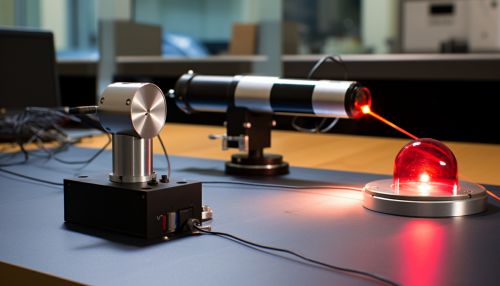Spectroscope
Introduction
A spectroscope is an instrument used in spectroscopy, the study of interactions between matter and electromagnetic radiation. It is designed to separate and measure spectral lines, which are unique to each element and provide valuable information about the physical properties of an object. This article delves into the intricate workings of a spectroscope, its history, types, and applications in various fields of science.


History
The spectroscope was first invented in the early 19th century by Joseph von Fraunhofer, a German physicist and optical lens manufacturer. His invention was based on the earlier work of Newton and Wollaston, who had discovered that light could be split into its constituent colors using a prism. Fraunhofer improved upon this concept by adding a second prism to recombine the light, creating a more detailed and accurate spectrum.
Principles of Operation
The operation of a spectroscope is based on the principle of diffraction, the bending of light as it passes around an obstacle or through a narrow slit. When light enters the spectroscope, it is first collimated (made parallel) by a lens or mirror. It then passes through a narrow slit, which acts as the source of light for the spectroscope. This light is then diffracted by a prism or diffraction grating, separating it into its constituent colors or wavelengths.
Types of Spectroscopes
There are several types of spectroscopes, each designed for specific applications and types of analysis. These include:
Prism Spectroscope
The prism spectroscope uses a prism to diffract light. It is the simplest type of spectroscope and was the first to be invented. Despite its simplicity, it is still widely used in educational settings due to its ease of use and low cost.
Diffraction Grating Spectroscope
The diffraction grating spectroscope uses a diffraction grating, a surface with thousands of parallel lines, to diffract light. This type of spectroscope offers higher resolution and accuracy than a prism spectroscope, making it suitable for professional and scientific applications.
Fourier Transform Spectroscope
The Fourier transform spectroscope uses a mathematical technique called Fourier transform to analyze the light. This type of spectroscope is capable of analyzing multiple wavelengths simultaneously, making it ideal for complex analyses.
Applications
Spectroscopes are used in a wide range of scientific fields, including physics, chemistry, astronomy, and environmental science. They are used to identify elements, analyze chemical reactions, study celestial bodies, and monitor environmental conditions, among other applications.
